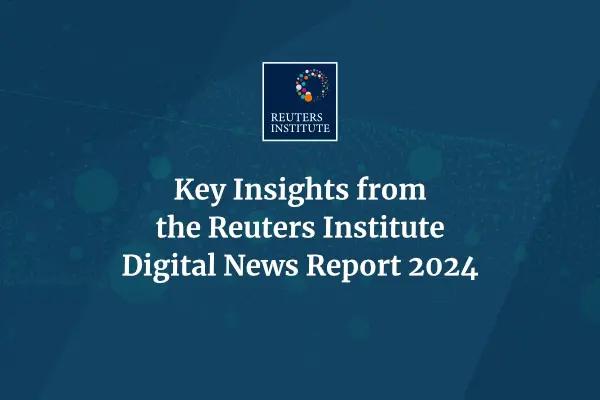Key Insights from the Reuters Institute Digital News Report 2024

Every year, the Reuters Institute Digital News Report presents the latest insights on digital news consumption and production; this year’s instalment is no exception. With data from six continents and 47 markets, the report paints a sobering picture of the state of independent journalism, and offers ideas on what those in the industry can do to rescue a troubled business.
In this post we explore the report’s key findings and assess their implications for the future of journalism.
1. Shifting Technology
A major technology shift is underway, disrupting the news industry. Online platforms have upended how people locate information and consume entertainment. While these platforms have made life easier, they have also challenged traditional publishing models.
Platforms are aware of the changes in consumer behaviour, and are especially attuned to consumers’ concerns over misinformation. As a result, some platforms, particularly Meta, have been adapting to this shift by deprioritising news content and reducing support for the news industry. In turn, video-based platforms such as YouTube, TikTok, and Instagram are becoming more important for the consumption of news.
Older consumers (people over 35 years of age) still access video content on news websites, the report found, but third-party platforms are becoming more important for video news consumption, especially among younger viewers.
The Digital News Report also found that news consumers prefer video formats for three reasons: trustworthiness, convenience, and diverse perspectives. However, data show that the majority of people still use a combination of text, video, and audio to consume news.
2. Trustworthiness
Trust in the news has remained steady at 40 percent over the past year, but is still 4 percent lower than it was during the COVID-19 pandemic. In 2024, a year filled with elections, many readers are concerned about the reliability and trustworthiness of content. Politics is the topic that draws the most concern about bias. Of the countries surveyed in the report, Finland continues to have the highest overall trust levels, at 69 percent, whereas Greece and Hungary, with 23 percent each, have the lowest. Concerns over excessive political and business influence on the media drive these negative perceptions.
Technology is adding to the distrust. For instance, a rise in deep fakes – life-like video, audio or text created by artificial intelligence (AI) – have polarised audiences on key issues, from elections in the United States to conflict in the Middle East. But while readers don’t feel comfortable with AI-generated news on politics, crime and local news subjects, they are more accepting of AI-generated news about sports, culture, or entertainment, where personalised content is more valuable and the consequences of mistakes less severe.
Most survey respondents expect news to be accurate, fair, and free from sensationalism. They also want transparency regarding any agendas or biases, including issues of diversity, and expect media outlets to acknowledge mistakes and not shy away from investigating the rich and powerful. Transparency and openness are the most important factors for people when choosing which news organisations to trust.
3. News Payment
Challenging advertising markets, rising costs, and decreasing social media traffic have increased financial pressure, particularly on publishers that depend on platform distribution.
In response, many news organisations are introducing reader payment models, such as subscriptions, memberships, and donations. While paid models have shown some success in wealthier countries, mainly Norway, Sweden, the United States and Australia, they have proven more difficult to implement in regions with lower levels of disposable income.
(As an aside, Superdesk, our award-winning open-source headless CMS supports different revenue models and offers a Paywall Component to help publishers manage their monetisation strategies).
Despite the focus on reader revenue, free access remains the most used strategy. According to the report, just 17 percent of readers are willing to pay for news content, and most – 57 percent – are unwilling to pay anything.
Key Takeaways
A platform shift is currently underway, with a growing focus on retaining traffic within their environments, and prioritising formats that enhance engagement, such as video. Many news media organisations struggle to perform well in this environment. If news media companies can demonstrate that they are accurate, fair, open, and transparent, they are more likely to receive a positive response from audiences.
At Sourcefabric, our open-source approach ensures that our tools are designed with transparency in mind, allowing users to freely download, use, and change them according to their needs.
Contact us to learn more about our products, and check out the Sourcefabric blog for the latest news. Subscribe to our monthly newsletter to stay informed about industry trends and innovations.
